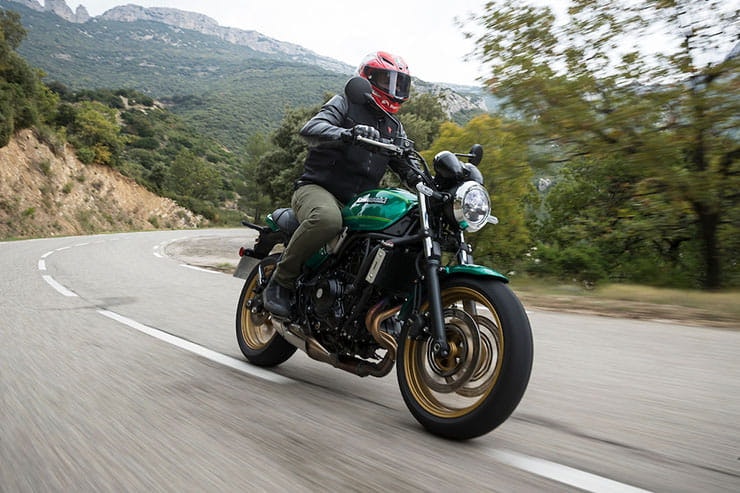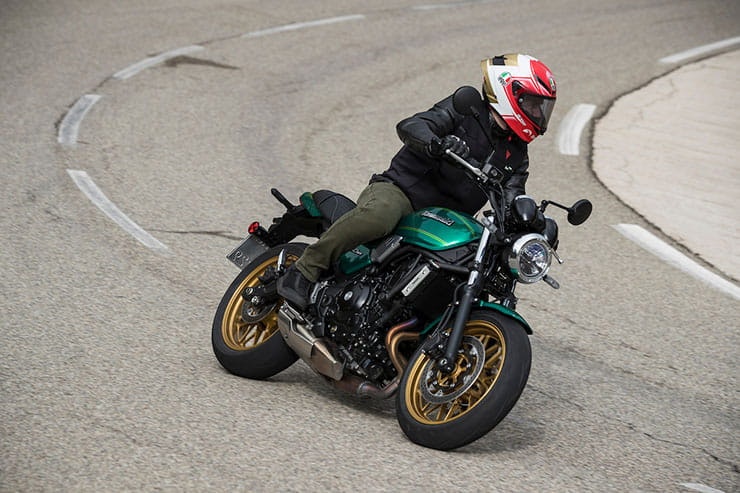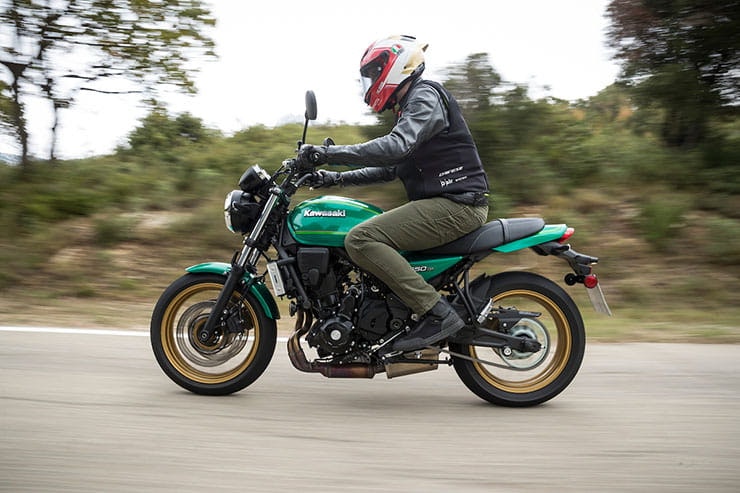Kawasaki Z650 RS (2022) - Review
By Michael Mann
BikeSocial Managing Editor
04.11.2021
I’m never going to get through this review without using the word ‘retro’, as defined in Wreck-It Ralf, the Disney movie, as watched recently by my four-year old, as ‘old but cool’, and I kinda like that. In fact, I might think of myself as retro from now on.
Kawasaki’s marketeers may have stretched that meaning further because despite automotive history suggesting RS is the abbreviation of ‘Rally Sport’, Team Green has superseded that by rolling out ‘Retro Sport’ for the Z650RS. After all, this new 2022 middleweight naked has taken its styling cues from the 1977 B1 edition of the Z650 - yep a 44-year old Zed, although that had twice as many cylinders as the modern day’s parallel twin; a cause for consternation among the social media-based opinion sharers.
Essentially, it’s really only the styling rather than the mechanical components that separate it from the latest incarnation of the marque’s Z650 which landed in dealerships about 10 minutes before COVID-19 paused the world in 2020. And while the Z650, on which this RS model is heavily based, had the potentially more crowd-pleasing Yamaha MT-07 as its main rival, there’s no escaping the Japanese competitor because the XSR700 is just as focused on old school styling as Kawasaki’s Z650RS.
The Z range’s history is littered with four-cylinder engines so the purists might be looking down their noses at this twin and judging it before riding it but this budget-friendly middleweight naked has its sights set on the less experienced or new-to-riding end of the market with an A2 compliant kit also available for the model.
But just how exciting can a 650 twin be? How much do you need to wind it on? Will 67bhp please the more experienced rider? We saddled up in Marseille for a day by the seaside and up into the hills.
Lightweight and narrow chassis, perfect for low speed manoeuvrability
Perky, sprightly engine with a wide spread of torque and available revs
Styling – might just give it the edge in this competitive class
Soft seat and rear suspension
High footpegs
A little snatchy on/off throttle at low rpm
Kawasaki Z650RS (2022) - review
BikeSocial’s Michael Mann takes the retro-focussed Z650RS with the mechanical components of the Z650 and added 1977-style makeover out for the day in the South of France on the European press launch to see where it slots into a competitive market
Kawasaki Z650RS (2022) Price
How much is the 2022 Kawasaki Z650RS? £7549 and is available in three colours: Metallic Spark Black, Candy Emerald Green or Metallic Moondust Grey / Ebony. The latter two will increase the price by £150 each and you can expect them to be lining up in dealerships once you’ve finished reading this sentence.
It’s a fiercely competitive field where many machines are deemed affordable and damn good value for money, the Kawasaki nestles in nicely among offerings from the three other Japanese brands and several European ones too. I’ve picked the closest four and their relevant specifications further down.
What is interesting about Kawasaki’s hopes for this model is that the UK operation has ordered in more Z650RS bikes than Z650’s and Ninja 650’s.
With a 19% deposit, this tasty Z650RS can be yours for less that £100 per month after a £1500 deposit, here’s an official PCP example to whet your appetite:
Power and torque
Because the engine is identical to the Z650, the performance levels of the Z650RS match, with peak power of 67.3bhp / 50.2kW available at 8000rpm while peak torque is 64Nm / 47.2 ft lbs at 6700rpm. And of course, the A2 compliant-bike, when fitted with the dealer-fit kit will restrict the performance to the permitted 35kW / 47bhp level.
Engine, gearbox, and exhaust
The predominantly blacked-out 649cc parallel twin cylinder motor is a compact unit which fits neatly with the overall look and feel of the bike. Its width is why it’s an ideal element in this friendly, easy-going, lighter-weight motorcycle but don’t be fooled into thinking this an underpowered, wheezy, Euro 5-strangled party pooper. Oh no, the power-to-weight ratio of 187kg and 67bhp provides a close enough match for its competitors and makes riding a very pleasant experience – the breadth of revs and available torque plus tall gearing means less gear change fatigue, particularly around town. It’s a polite and charming engine that has no concerns about being revved all the way to the peak power output of 8000rpm from as low down as 2500rpm offering plenty of low-down grunt… so much so the front wheel can be encouraged to momentarily leave the ground at full throttle in first. And because it’s not a supernaked, it doesn’t spin up to that level too quickly and therefore runs out of puff at 10mph increments. The exhaust note is rather pleasing too and could easily match the twins of the late 70s with its growl with verges on the thump of a single cylinder at low rpm.
Low to mid revs is where the Kawasaki likes to be but isn’t overwhelmed should motorway cruising and higher speed acceleration for overtakes be necessary.
Pootling around town or in full-on city rush-hour attack mode, the Z650RS has the right attributes to perform with the well-connected throttle action and super light clutch lever and an easy-to-judge bite point which almost makes it unstallable. The clutch and brake levers are both span adjustable by the way. That said, at low revs the initial on/off throttle action can be jerky – all too evident when filtering or at low town speeds in first and second gears. It can make even the most experienced rider look a little clumsy.
A 6-speed gearbox is precise enough with a gear lever throw that offers that reassuring click, though you need to be quite deliberate with the motion especially between first and second. The lack of a quickshifter as standard fit or as an option certifies the retro-ness and target audience. It’s a light enough gearchange to warrant the added expense and weight.
Handling, suspension, and weight
The seat height of Z650RS is 820mm compared to the Z650’s 790mm which makes the bike feel taller and even narrower. An 800mm optional low seat is available but because the waist of the bike is narrow just like the engine, handlebars and chassis, it feel like a natural and upright riding position. At 6ft (183cm) tall with a 33” (84cm) inside leg, I felt the peg position was too high, possibly to allow room for the silencer and certainly for ground clearance but, and you might agree when looking at the side-on photos from the press ride, my initial cramped feeling did give way to feeling more comfortable as the day progressed. I obviously got used to it but it’s something to be wary of if you’re a tall rider. Make sure your test ride is long enough to understand its comfort.
To keep the target price reasonable and competitive, the suspension is very basic. Unadjustable 41mm, ‘right way up’ forks on the front are more than capable for the type of riding owners are likely to be doing, and there’s no excessive diving under harder braking. At the rear is a pre-load adjustable and near horizontal monoshock which is feels very soft when frolicking through Marseille’s less-than-perfect roads and over speed humps. I’m not exactly a big lad and at 14 stone (89kg) expected something with a little more damping. Thankfully, out on the open roads and carrying a little more speed the suspension coped well. Up into the mountains and via a selection of 1st gear hairpins through to mid-3rd gear sweepers and the slimline, Dunlop Sportmax Roadsport 2-shod Kawasaki demonstrated a string to its bow that I wasn’t expecting. Well poised and quick steering with that low-speed punch proved very pleasing. It’s balanced under braking, leans well and offers enough more than enough confidence for the rider to enhance their ability.
Kawasaki Z650RS (2022) Comfort and economy
Speaking of seats and comfort, the one-piece seat is soft. Some may like the level of squishiness and I got used to it without it being too much of an issue as the ride evolved. The material used is fairly grippy too so you won’t be sliding around on it, and it suits the overall look.
I found the pegs to be quite high but it wasn’t too off-putting and didn’t distract from the ride enjoyment. The flat seat and low 12-litre fuel tank mean you sit perched on top of the bike and with little weather protection could prove to be a little chilly on the cooler days, or wet on the rainy days. Any change in that rider triangle between footpeg to seat front to handlebar would upset the steering or balance of the bike. I’d be interested to hear from any pillions out there. The seat appeared to offer just enough room but again, the pegs seemed high. A pillion grab bar is an optional extra and looks decent enough to fit as a styling accessory or to tie luggage to, even if you never have any intention of carrying anyone.
With a 12-litre capacity, the fuel tank is 3-litres lighter than the Z650 which is down to styling and a project requirement to fit that retro USP, it’s also narrow and contributes further the ergonomics. The rather excitable press ride was a little more than 70-miles in total and the LCD display nestled in between the classy, old-school twin clocks told me of a 5.2l. / 100km economy which works out to be 54.3mpg against the claimed 62.7mpg. Either way you should be able to eek 135-miles out a tank before getting too concerned.
Brakes
Off the throttle and the engine braking is sufficient without being jolty but apply the span-adjustable brake lever and the twin-pot Nissin callipers grab the twin 300mm discs with excellent efficiency. Commuters intent on scything through slow-moving city traffic can be safe in the knowledge that the Z650RS brakes should stand up to many would-be hazards.
I’m becoming more of a rear-brake user recently and found myself squeezing that right foot down to offer a little more balance in the faster corners, and operating just a single 220mm disc, required more of a squeeze than first anticipated.
Rider aids, extra equipment, and accessories
If you fancy a little more growl from your 649cc twin than an £1800 Akrapovič Titanium system is available, though more practically the £287 low seat option reduces the seat by 20mm, radiator trim, USB socket, and aforementioned grab bar (£171) are among the official optional extras alongside a ream of sliders, covers and protectors.
The beauty of purity is the lack of complication. Sounds like one of those motifs from a t-shirt or Instagram story but unless anyone else has said it before, then I’m claiming it. It fits the Z650RS too because there’s nothing too tricky to figure out with this ride – no engine modes, cornering ABS settings or wheelie control configurations to get in the way of hopping on and riding off.
Rivals
I’ve chosen the most comparative quartet vs. the Z650RS though a further four could easily have been included. The below chart picks out a mix of price, power and styling that could all be easily compared to the Kawasaki. The Honda CB650R, for example, makes by far the highest peak power but is offset by its relatively meagre torque figure. Then again, it is a four-cylinder.
Here’s a high-level comparison chart:
Above: Mann lines up the ’77 Z650 B1 and its grandson, the ’22 Z650RS
Kawasaki Z650RS (2022) Verdict
The Z650RS is a premium competitor in this easy-to-ride, no frills, well put together, stylish, funky, learner-friendly, lightweight, middleweight category. And it should be seriously considered if this is the style of bike you’re aiming for. Whether that’s a smart and lithe commuter, a first big bike, a last big bike or just a feel-good bike.
Kawasaki says it’s “top priority target” with this RS is the younger or less experienced and I’d say the styling is really well suited to that crowd who’d appreciate the classic touches without really worrying about the heritage significance. The narrow chassis, ‘bars and seat are a cracking blend to create a nimble and sprightly motorcycle with an energetic engine to boot. That wide optimal rev range, tall gears, light clutch and deep rasp really add the personality to take chunks out of its rivals’ sales figures. I was worried about the lack of pizzaz or crowd-pleasing ability before riding and only when a back-to-back test can be organised, can I whip out the fun-o-meter. Just watch for that on/off throttle and longer distance comfort.
Kawasaki Z650RS (2022) Technical Specification
Photos: Kawasaki Europe
Video editing: Too Fast Media
What is MCIA Secured?
MCIA Secured gives bike buyers the chance to see just how much work a manufacturer has put into making their new investment as resistant to theft as possible.
As we all know, the more security you use, the less chance there is of your bike being stolen. In fact, based on research by Bennetts, using a disc lock makes your machine three times less likely to be stolen, while heavy duty kit can make it less likely to be stolen than a car. For reviews of the best security products, click here.
MCIA Secured gives motorcycles a rating out of five stars, based on the following being fitted to a new bike as standard:
A steering lock that meets the UNECE 62 standard
An ignition immobiliser system
A vehicle marking system
An alarm system
A vehicle tracking system with subscription
The higher the star rating, the better the security, so always ask your dealer what rating your bike has, and compare it to other machines on your shortlist.


